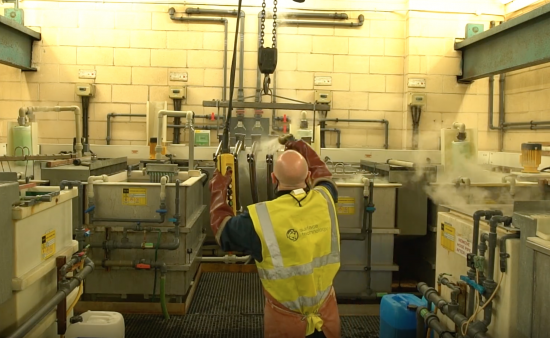Electroless nickel plating – everything you need to know
Electroless Nickel Plating (ENP) is the deposit of a nickel-alloy coating by chemical reduction – without the electric current that’s used in electroplating processes.
The majority of ENP for engineering purposes is a nickel phosphorus deposit containing 2 to 14% phosphorus.
The higher the phosphorus content the greater the corrosion resistance, however the compromise on increased phosphorus content is a decrease in hardness.

ENP is deposited by reducing nickel ions to metallic nickel with a chemical reducing agent such as sodium hydrophosphite. Thickness of 25-75m is common, high phosphorus ENP can edge above 75m although this does start to push the limits of ENP.
The benefits of electroless nickel plating
ENP offers excellent corrosion resistance to common corrodents such as salt water, carbon dioxide, oxygen and hydrogen sulphide.
High phosphorus deposits of ENP (10-14% phos) is also amorphous, which means that there are no grain or phase boundaries to create initiation sites for corrosion.
The uniformity of ENP versus electrolytic deposits is also advantageous, creating a uniformly thick coating across the whole substrate; even in slots, holes and inside walls of tubing.
Without heat treatment corrosion resistant high phosphorus ENP still provides good hardness and wear resistance properties.
ENP offers a cost-effective solution for applications subject to conditions where wear and corrosion are factors; extending service life and providing a lower cost alternative to corrosion resistant alloys, particularly where carbon steel suffers localised corrosion; flange attack or weld corrosion.
What are the properties of the deposit and factors affecting them?
ENP offers excellent corrosion protection and uniformity of deposit along with good hardness. The phosphorus content of the deposit can be altered to best fit the application.
At Surface Technology our technical team understand each customers’ application before recommending the optimum phosphorus level – the higher the phosphorus content the greater the corrosion resistance but lower the surface hardness.
Hardness of ENP can be increased by heat treatment but this produces a microcracked deposit with reduced corrosion resistance.
ENP deposits uniformly, even on complex shapes, unlike electroplating.
How does heat treatment affect ENP?
ENP is at its most corrosion resistant in its amorphous phase. Heat treatment causes particles of nickel phosphide to precipitate, destroying the amorphous character of the deposit. With high phos ENP deposits this occurs at temperatures between 330 and 360C.
How well does ENP adhere to substrates?
Adhesion is dependent on effective cleaning of the substrate. With good surface preparation adhesion to carbon steel is between 200-420 MPa. With stainless steels the bond strength is usually between 160-200 Mpa.
What factors affect plating quality?
There are several factors affecting plating quality and the majority should be effectively managed by your surface finishing partner.
– Surface preparation: Rough, badly machined surfaces with uneven metal surfaces, burrs or cold shuts cannot be effectively plated.
– Cleaning: Surfaces must be free from oils, dirt and soaps formed by saponification of oils by alkaline cleaners.
– Control of the plating baths: Temperature, pH, nickel ion concentration and hypophosphite concentration all need to be carefully managed to ensure high quality, consistent plating finish is achieved.
What are the fabrication / finishing requirements before plating?
Weld spatter should be removed, sharp edges radiused and weld roots ground smooth. When refurbishing / remanufacturing components it is important that corroded areas are ground to a flat surface.
Other key considerations
When looking to choose a suitable partner for your electroless nickel plating requirements it is important to check for several factors:
– Is grit blasting available as a service pre plating when required?
– Will surface inspection be completed prior to plating?
– Are the chemicals supplied by a certified ENP product supplier?
– Are ENP solutions made up with demineralised water?
– Is continuous filtration of the bath to one micron done along with air agitation?
– Is bath chemistry monitored regularly?
– How regularly are baths cleaned?
– Is inspection carried out to sufficient levels?
Find out more about the electroless nickel plating service we offer at Surface Technology or contact us now to discuss your requirements further.
Register below for our monthly email and stay up-to-date with the latest surface engineering white papers, case studies and innovation news.

